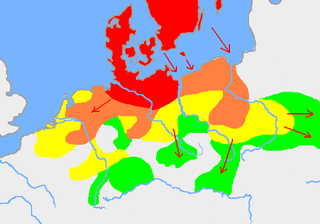Loading AI tools
Group of extinct Indo-European languages in the Germanic family From Wikipedia, the free encyclopedia
The East Germanic languages, also called the Oder-Vistula Germanic languages, are a group of extinct Germanic languages that were spoken by East Germanic peoples. East Germanic is one of the primary branches of Germanic languages, along with North Germanic and West Germanic.
| East Germanic | |
|---|---|
| Oder-Vistula Germanic, Illevionic (uncommon) | |
| Geographic distribution | Varying depending on time (4th–18th centuries), currently all languages are extinct Until late 4th century: Central and Eastern Europe (as far as Crimea) late 4th–early 10th centuries: Much of southern, western, southeastern, and eastern Europe (as far as Crimea) and North Africa early 10th–late 18th centuries — disputed (cp. Crimean Gothic): Isolated areas in Eastern Europe (as far as Crimea) |
| Linguistic classification | Indo-European
|
| Subdivisions |
|
| Language codes | |
| ISO 639-5 | gme |
| Glottolog | east2805 |
 The distribution of the primary Germanic languages in Europe c. AD 1:
East Germanic † | |
The only East Germanic language of which texts are known is Gothic, although a word list and some short sentences survive from the debatedly-related Crimean Gothic. Other East Germanic languages include Vandalic and Burgundian, though the only remnants of these languages are in the form of isolated words and short phrases. Furthermore, the inclusion of Burgundian has been called into doubt.[1] Crimean Gothic is believed to have survived until the 18th century in isolated areas of Crimea.[2]: 189

East Germanic was presumably native to the north of Central Europe, especially modern Poland, and likely even the first branch to split off from Proto-Germanic in the first millennium BC.
For many years, the least controversial theory of the origin of the Germanic (and East Germanic) languages was the so-called Gotho-Nordic hypothesis: that they originated in the Nordic Bronze Age of Southern Scandinavia and along the coast of the northernmost parts of Germany.[5]
By the 1st century AD, the writings of Pomponius Mela, Pliny the Elder, and Tacitus indicate a division of Germanic-speaking peoples into large groupings with shared ancestry and culture. (This division has been taken over in modern terminology about the divisions of Germanic languages.)
Based on accounts by Jordanes, Procopius, Paul the Deacon and others, as well as linguistic, toponymic, and archaeological evidence, the East Germanic tribes, the speakers of the East Germanic languages related to the North Germanic tribes, had migrated from Scandinavia into the area lying east of the Elbe.[6] In fact, the Scandinavian influence on Pomerania and today's northern Poland from c. 1300–1100 BC (Nordic Bronze Age sub-period III) onwards was so considerable that this region is sometimes included in the Nordic Bronze Age culture.[7]
There is also archaeological and toponymic evidence which has been taken as suggesting that Burgundians lived on the Danish island of Bornholm (Old Norse: Burgundaholmr), and that Rugians lived on the Norwegian coast of Rogaland (Old Norse: Rygjafylki).[citation needed]
Seamless Wikipedia browsing. On steroids.
Every time you click a link to Wikipedia, Wiktionary or Wikiquote in your browser's search results, it will show the modern Wikiwand interface.
Wikiwand extension is a five stars, simple, with minimum permission required to keep your browsing private, safe and transparent.